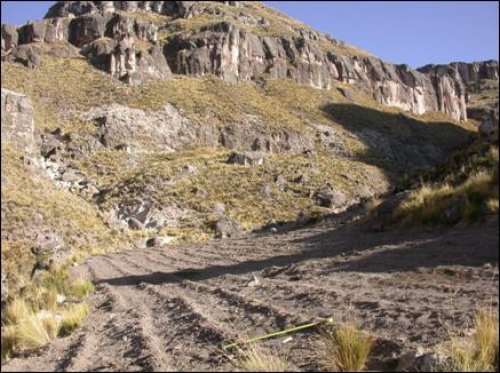Vegetation and dryland agriculture in the study area
The Callalli area consists primarily of high elevation grassland punaecology (1973). Dry bunch grasses are available much of the year in this area, but during the wet season (austral summer) a greater variety of grasses become available and herds are brought to the valley to exploit the pasture of chilliwuaand llapagrasses.
Callalli and Sibayo lie in the upper reaches of agriculture at this latitude and evidence of abandoned fields are visible in the upper valleys. Plants like tubers, oca, and chenopodium were historically viable at this altitude (Echeverría 1952 [1804]), although microclimatic variability is influential in these conditions of marginal dryland agricultural production. Guillet (1992: 24) cites evidence for climate change from historical sources that describe the cultivation of maize above the current limits for this crop, and coca, membrillo, and peppers on terraces that lie at altitudes where these crops are not feasible today. Wernke (2003: 51-52) considers the significance of climate change evidence from ice cores in mountain ranges to the east for Colca valley culture history and agriculture.
In Markowitz's (1992) ethnographic study at Canaceta, a village at 4000 masl and approximately 12 km upstream of Callalli, villagers explained that they had formerly engaged in agriculture at this altitude, but that they had recently abandoned the practice due to lack of rainfall. She observes that practicing a mixed subsistence system of agriculture and pastoralism was an important cultural ideal in the Canaceta, but that in recent years due to changes in the climate and in economic circumstances they had increasingly become specialized on pastoral production complemented by exchange (Markowitz 1992: 48). Under modern circumstances there is probably not a very high return on labor invested in agriculture in this area as the increased economic integration, and an improved transportation infrastructure with intensive farming areas at lower elevations, has further induced residents towards specialized economic practices. The current distribution system emphasizes pastoral production in the highlands and higher yield agriculture on lands at lower elevations.
Figure 4-9. Tuber cultivation at 4200 masl surrounded by large tuff outcrops.
In the course of survey in 2003 cultivation was observed in a few high altitude locations, such as the upper reaches of Quebrada Taukamayo. The plots were at 4200 masl in a north-north-east facing (10°) aspect and a mild slope (8°). The area is relatively sheltered by the presence of lava tuff flows (see Figure 4-9) that may have had a temperature moderating effect acting like large terrace stones that are known to reduce diurnal variation by absorbing heat during the day and releasing heat at night in the immediate valley microclimate (Schreiber 1992: 131).

